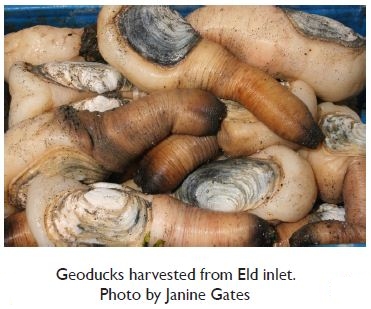Geoduck Aquaculture Is Not Ecosystem BasedBy Harry Branch
A couple of years later the tubes are removed and the geoducks grow. An enormous increase in densities of the world's most enormous burrowing clam would seem likely to displace other benthic organisms, those organisms that live under the bottom of the bay such as tube worms and burrowing shrimp. Unlike these creatures, geoducks don't move nutrients and oxygen around in the benthos and they don't themselves become food for other marine organisms. There is virtually no data on the benthic community during the growth stage. Then there is the harvest eight or so years after planting in which the beach is liquefied with hydraulic jets. In all likelihood the area is soon re-planted. By contrast, natural marine ecosystems are the most productive, resilient and maintenance free. Natural ecosystems are most productive because of their complexity. Primary production, mostly the work of phytoplankton, is where life in the sea begins. Secondary production, the consumption of primary producers, is mostly the work of zooplankton. Other zooplankton and larger creatures in turn consume these. At the top of the food web lie the apex predators. The more layers in the web the more opportunities for us. We can harvest not only herring and smelt but also the rockfish and salmon. The more layers, the richer the ecosystem. Richness is a measure of the variety of species occupying an area. An ecosystem with more species is more resilient. Disease is less apt to spread because of the greater space between individuals of the same species. In a rich ecosystem some species are quicker to settle after a disturbance than others so the system recovers more quickly. A single disease is less likely shut everything down. Natural systems are maintenance free. They don't require intervention on our part in order to continue to exist. Problems in an ecosystem often fi rst appear as changes among its apex predators. Diving ducks are good indicators. Their numbers have generally declined in Puget Sound, some species dramatically. One study of Western Grebes shows a 95% decline. Benthic feeding diving ducks such as scoters, those ducks that would be feeding where geoduck aquaculture occurs, have declined most of all. (http://pugetsoundscienceupdate.com/pmwiki.php?n=Chapter2a.MarineBirds) The goal of shellfish aquaculture as often practiced is biological sameness. Burrowing shrimp, crabs including Dungeness and rock crabs, various clams, sand dollars, starfish, seaweed, grasses, perch and other fishes, and waterfowl including scoter ducks are all considered pests. Aquaculture's impacts on water quality seem to vary according to other parameters. Shellfish do not clean nutrients out of water; they remove phytoplankton that has ingested nutrients. Reducing phytoplankton could theoretically even reduce nutrient uptake in the system. The ingestion of secondary producers would be more of a problem. Secondary producers such as copepods recover more slowly than phytoplankton. They represent an important linkage in the food web. And secondary producers control phytoplankton over-production better than benthic filter feeders because they're spread out throughout the water column. There is no published literature on the ingestion of zooplankton or on the dispersal of forage fish larvae through shallow, densely planted intertidal beds. The first step in the recovery of the Puget Sound ecosystem should be restoration. Get back to what we once had. Only after restoration should we consider enhancement, improving production by reducing limiting factors. Geoduck aquaculture is an attempt to manage the ecosystem into improved productivity in ways that are not ecosystem based. Ecosystem Based Management is the key to recovery. Harry Branch has a Masters Degree in Environmental Studies with a focus on marine reserves as a tool in fishery management and is a frequent contributor to the Green Pages.
Back to Home page. |

 Geoduck aquaculture entails three major disturbances. In the first, four inch in diameter PVC tubes are driven into the beach, one per square foot. Three baby geoducks are planted in each tube. The tubes are covered with nets to protect the young geoducks from predation. The tubes also prevent drying at low tide, turning that part of the all-important intertidal zone into part of the subtidal zone.
Geoduck aquaculture entails three major disturbances. In the first, four inch in diameter PVC tubes are driven into the beach, one per square foot. Three baby geoducks are planted in each tube. The tubes are covered with nets to protect the young geoducks from predation. The tubes also prevent drying at low tide, turning that part of the all-important intertidal zone into part of the subtidal zone.